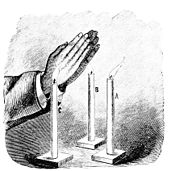Experiment 60.—Cut out two small triangles of copper-foil or tinsel, of the same size, and with wax fasten one on the end of each of the prongs of a tuning-fork. Put the fork in the wooden block, and set up the guide (as in experiment, Fig. 21). Prepare a strip of smoked glass, and then make the fork vibrate and slide the glass under it, and get two traces, one from each prong.
Holding the glass up to the light, you will see the double trace, as shown in Fig. 37. You observe that the wavy lines move apart, and
then draw together. This shows us that the two prongs, in vibrating, do not move in the same direction at the same time, but always in opposite directions. They swing toward each other, then away from each other.
Experiment 61.—What is the effect of this movement of the prongs of the fork on the air? A simple experiment will answer this question.
Place three lighted candles on the table at A, B, and C (Fig. 38). Hold the hands upright, with the space between the palms opposite A, while the backs of the hands face the candles B and C. Now move the hands near each other, then separate them, and make these motions steadily and not too quickly. You thus repeat the motions of the prongs of the fork.
While vibrating the hands, observe attentively the flames of the candles. When the hands are coming nearer each other, the air is forced out from between them, and a puff of air is driven against the flame A as is shown by its bending away from the hands. But, during the above movement, the backs of the hands have drawn the flames toward them, as shown in Fig. 38. When the hands are separating, the air rushes in between them, and the flame A is drawn toward the hands by this motion of the air, while at the same time the flames at B and C are driven away from the backs of the hands. From this experiment it is seen that the space between the prongs and the faces of the prongs of a fork are, at the same instant, always acting oppositely on the air.
This will be made clearer by the study of the diagram, Fig. 39.
This figure supposes the student looking down on the tops of the prongs of the fork. Imagine the prongs swinging away from each

